This article focuses on visiting Auschwitz-Birkenau from my tourist perspective in terms of entry tickets, getting to Oswiecim, Poland and getting around the camps. Keep in mind that my criticism of how our tour went in no way diminishes my solemn respect for this sacred place.
Our tour experience was miserable. The daytime late July temperature of 30 Celsius/86F. was something we were prepared to endure. The disorganization of entering Auschwitz with our printed tickets was something we were surprised to experience considering more than 1.5 million visitors a year tour the camp.
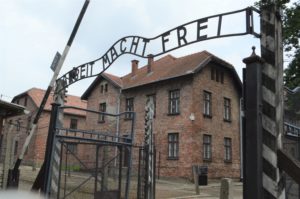
What is Auschwitz-Birkenau?
Auschwitz-Birkenau were the largest complex of Nazi concentration camps during World War II. They were used as prison labor camps and extermination camps. In addition to the main complex of Auschwitz and Birkenau, dozens of small labor camps were affiliated with Auschwitz. Manufacturing companies contributing to the war effort contracted with the Nazis for a cheap labor pool among the imprisoned population. An inability for a prisoner to work generally meant a death sentence.
The exact number of people imprisoned in Auschwitz-Birkenau during the war is unknown due to efforts by the Nazis to eradicate records and destroy evidence of the extent of the mass extermination of prisoners in the camps. Best estimates are in the range of 1.3 million prisoners were imprisoned in Auschwitz and Birkenau camps between 1940 and 1945, of which, about 1.1 million died. Jews comprised around 85 to 90% of deaths. Polish intelligentsia and resistance, Soviet POWs and Roma were the other main groups of prisoners.
Auschwitz-Birkenau were liberated by the Soviet Army on January 27, 1945. This date in January is recognized annually as International Holocaust Remembrance Day.
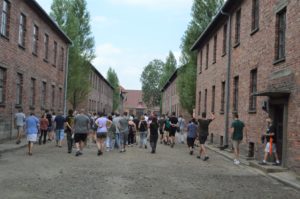
Birkenau, also known as Auschwitz II, came under construction in October 1941 and opened in March 1942. Originally this larger camp was designed to house 125,000 Russian POW prisoners the Nazis anticipated. Birkenau is the site of the purpose-built gas chambers, designed for mass extermination of the Jews in Europe and other undesirables to the Nazi regime. About 90% of the 1.1 million prisoners who died at Auschwitz were in the Birkenau camp.
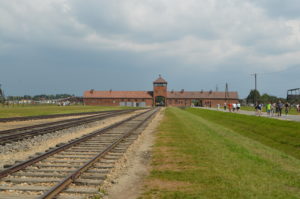
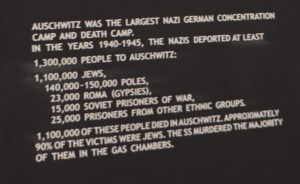
Where is Auschwitz?
Auschwitz-Birkenau camps are located at the town of Oswiecim, 70km west of Krakow, Poland.
Dozens of buses travel between Krakow and Oswiecim daily in about a 90 minute one-way ride. Most of the buses travel directly to Auschwitz I Museum. Bus ticket price is about 30pln round trip.
Train travel is cheaper at about 20pln round trip in 2 hours each way. The train station is 2km from Auschwitz I Museum. A bus ticket from Oswiecim train station to Auschwitz is 2.70pln or about a 20 minute walk.
The main tour requiring an entry ticket is for Auschwitz I, the original camp. Many of the buildings in Auschwitz I are the original buildings that were converted into a museum with informational and memorial exhibits inside the buildings.
Birkenau is a separate location about 3km from Auschwitz. A free shuttle bus runs every 10 minutes between Auschwitz I and Birkenau camp, also called Auschwitz II.
Birkenau is a far larger camp area than Auschwitz. Visitors do not need an entry pass to walk around Birkenau.
Visitors can ride the shuttle bus and tour Birkenau with or without a guide. Birkenau is where the main gas chambers were constructed for the mass extermination of prisoners. The gas chambers at Birkenau are now ruins, blown up by the Nazis before they evacuated the camp and retreated west to Germany as the Soviet army advanced across Poland in late 1944-early 1945. Auschwitz I Museum camp has a smaller reconstructed gas chamber.
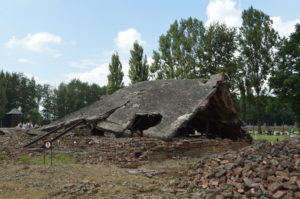
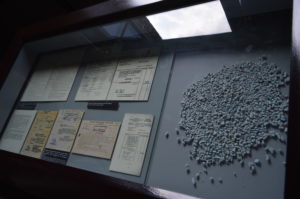
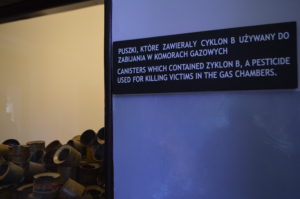
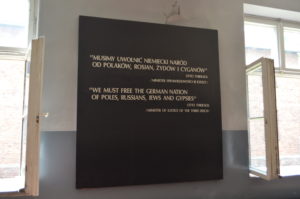
The tour involved walking through exhibits in about 4 buildings. One of the barracks displayed large rooms filled with personal belongings like eyeglasses, tons of hair, luggage, dishes and ceramics.
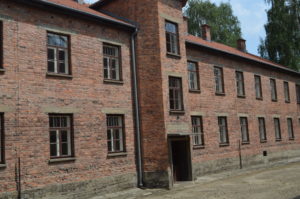
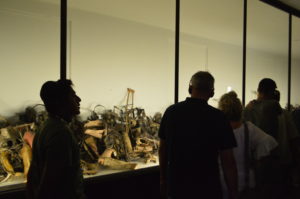
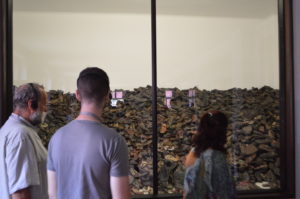
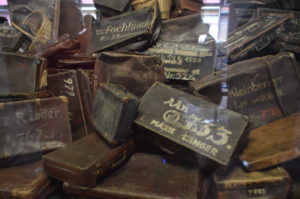
Prisoner Barracks
Another barracks building displayed hundreds of photos of individual prisoners and prison life sleeping conditions and bathrooms.
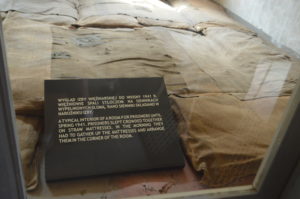
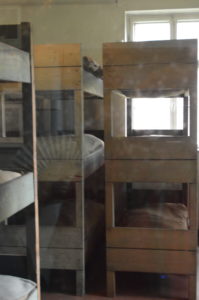
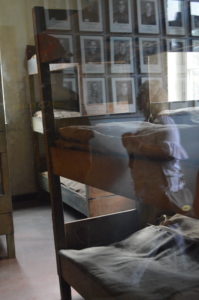
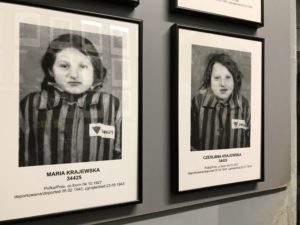
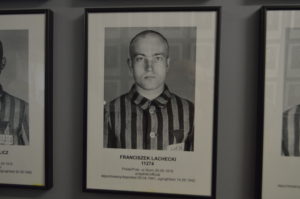
Auschwitz Blocks 10 and 11 – the prisoners prison

The part of the tour of Auschwitz Block 11, the camp prison barrack known as the ‘Death Block’, was especially memorable for the stifling heat with the crowd shuffling through the corridors of the prison block and into the cramped basement cells.
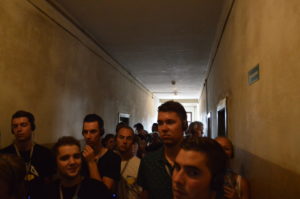
I could no longer hear my tour guide through the headset due to the tour guide of the group following us standing beside me speaking English to his group.
Between Sep 3-5, 1941, there were experiments conducted in the basement of Block 11 to test the effectiveness of Zyklon B as a killing agent.
600 Soviet POWs and 250 Polish political prisoners were used for the experiment and murdered.
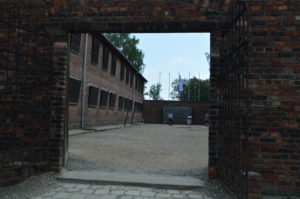
The courtyard between blocks 10 and 11 was the execution ground for Auschwitz.
No photographs are allowed of the prison cells in the basement of Block 11. Here is a view of basement cells taken from the courtyard.
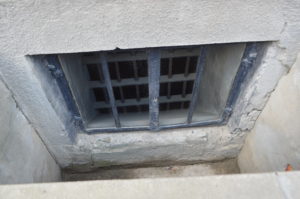

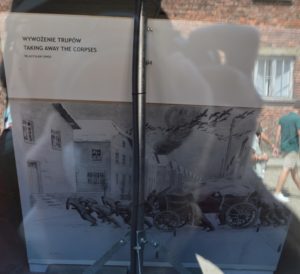
The remainder of the tour was mostly outdoors.
Several of the barracks hold national exhibits specific to Netherlands, Hungary, Poland, Czech Republic, France and Belgium. The 3.5 hour tour did not include visiting any of these exhibits.
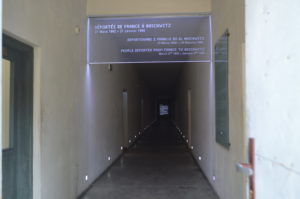
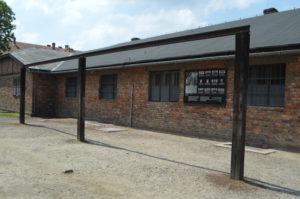
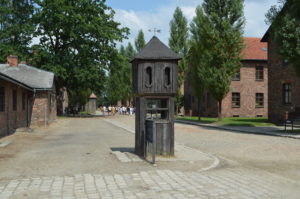
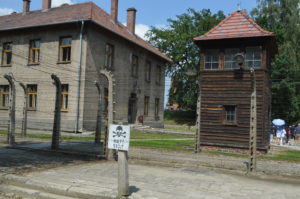
The location of the camp Gestapo building is where Rudolf Höss, a Nazi German SS-Obersturmbannführer (lieutenant colonel) and the longest-serving commandant of Auschwitz concentration was hanged on April 16, 1947.
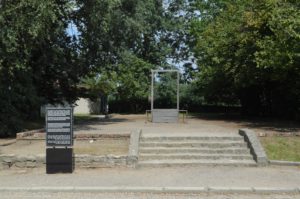
Auschwitz Gas Chamber and Crematorium
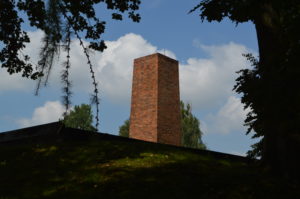
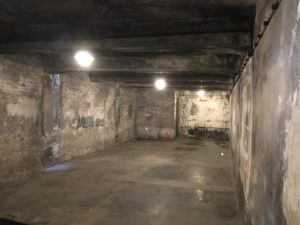
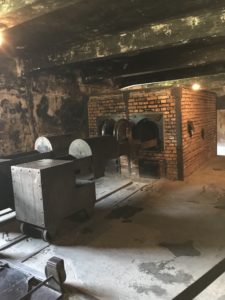
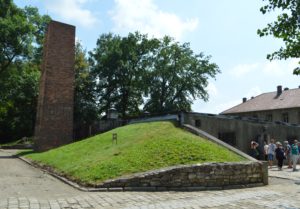
This was the end of the tour of Auschwitz I camp. We returned our headsets and the guide said meet her at the bus stop for the shuttle to Birkenau. And that was effectively the end of our guided tour. We could not hear her without the headset once we were at Birkenau.
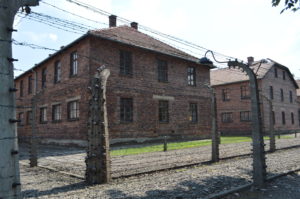
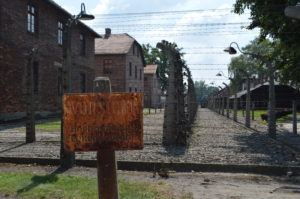
Birkenau – Auschwitz II
Most of Birkenau is ruins.
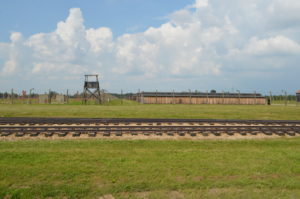

Birkenau is where several large gas chambers were constructed. The SS and doctors immediately separated incoming prisoners for those healthy enough to work and the remainder were sent to be executed. An informational sign stated 70-75% of prisoners were determined unfit for labor.
The weather was rapidly worsening and our guide hustled across the camp making it hard to take photos and keep up.
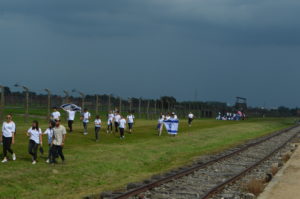
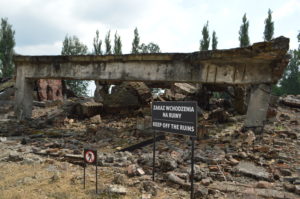
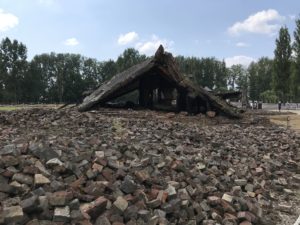

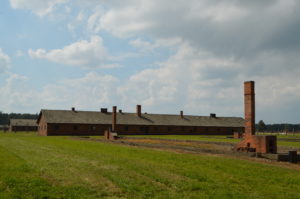
Our tour guide took a right turn towards some Birkenau barracks as the rain started. We headed straight for the shuttle bus, but did not reach it before a torrential downpour ensued. When the bus came, more people were waiting than could possibly fit on the bus. We packed into the bus as the last passengers to squeeze on, while the bus sat there for another 8 minutes until it was the scheduled departure time to go back to Auschwitz I.
Tourist Information You Need to Know
- Admission to Auschwitz I is regulated and controlled. You must have an entry ticket, bookable online to enter Auschwitz. Admission is free, however, you need to arrive early or late if you want to tour the camp on your own without a guide.
- “In the period from 1 April to 31 October, between 10:00 and 15:00, entry to the premises of the former Auschwitz I camp is permitted only with a Museum educator.”
- Birkenau is a separate location about 3km from Auschwitz. A shuttle bus runs every 10 minutes in summer between Auschwitz I and Birkenau camp, also called Auschwitz II.
- The main tour is the camp of Auschwitz I Museum. This is the controlled area requiring a metal detector check. No large bags are allowed Auschwitz I Museum camp. Backpacks and other bags must be stored at the free luggage storage area near the camp entrance. The maximum size of backpacks or handbags brought into the Museum does not exceed dimensions: 30x20x10 cm.
- A regular Museum educator guided tour is 3.5 hours. The Auschwitz I portion is about 2 hours. Then, about a 15 minute break when boarding a shuttle bus to Birkenau with your guide. Ticket price is 50pln (about $13.66usd)
- Most tours are in English or Polish. There are less frequent tours in many other languages. After passing through the metal detector security check, you pick up a receiver and headset for the tour and look for your language guide.
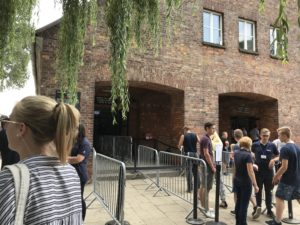
Apparently there is a movie of the Russian liberation of Auschwitz-Birkenau, a separate fee ticket, but we were never allowed inside the museum building entrance. After returning from Birkenau, and determined to find the movie theater, we were told it was too late to see the movie.
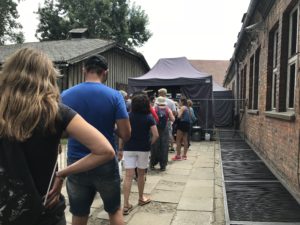
While the website recommends arriving 15 minutes before your tour, I recommend arriving 45 to 60 minutes before your tour, especially if it is peak season. We could not figure out where to go when we arrived. There were many hundreds of people standing around the parking lot and in front of the museum entrance building. One staff member directed me to the line for group entry, but then the museum staffer at that line looked at my ticket time, pointed to the 12:15 time and told me to wait.
By the time we were let into the security line, passed through the metal detector check, and received our headset device, our English language tour had departed. Another staff member in the courtyard told us to wait by the ‘Arbeit Macht Frei’ sign and a colleague would escort us to our tour group. After another 10 minutes with nobody coming to escort us, we went back to the entrance and asked for help again. We were escorted to our tour group approximately 30 minutes into our guided tour.
If I return to Auschwitz, I will be sure to go outside of summer season and tour the camps on my own at my own pace.
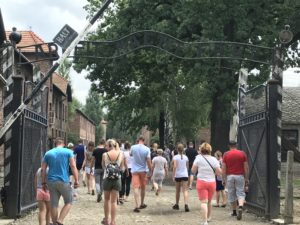
Here is a guide I think is very useful and informative on the advantages and disadvantages of booking a group tour or an individual tour of Auschwitz-Birkenau.
https://discovercracow.com/blog/visit-auschwitz/


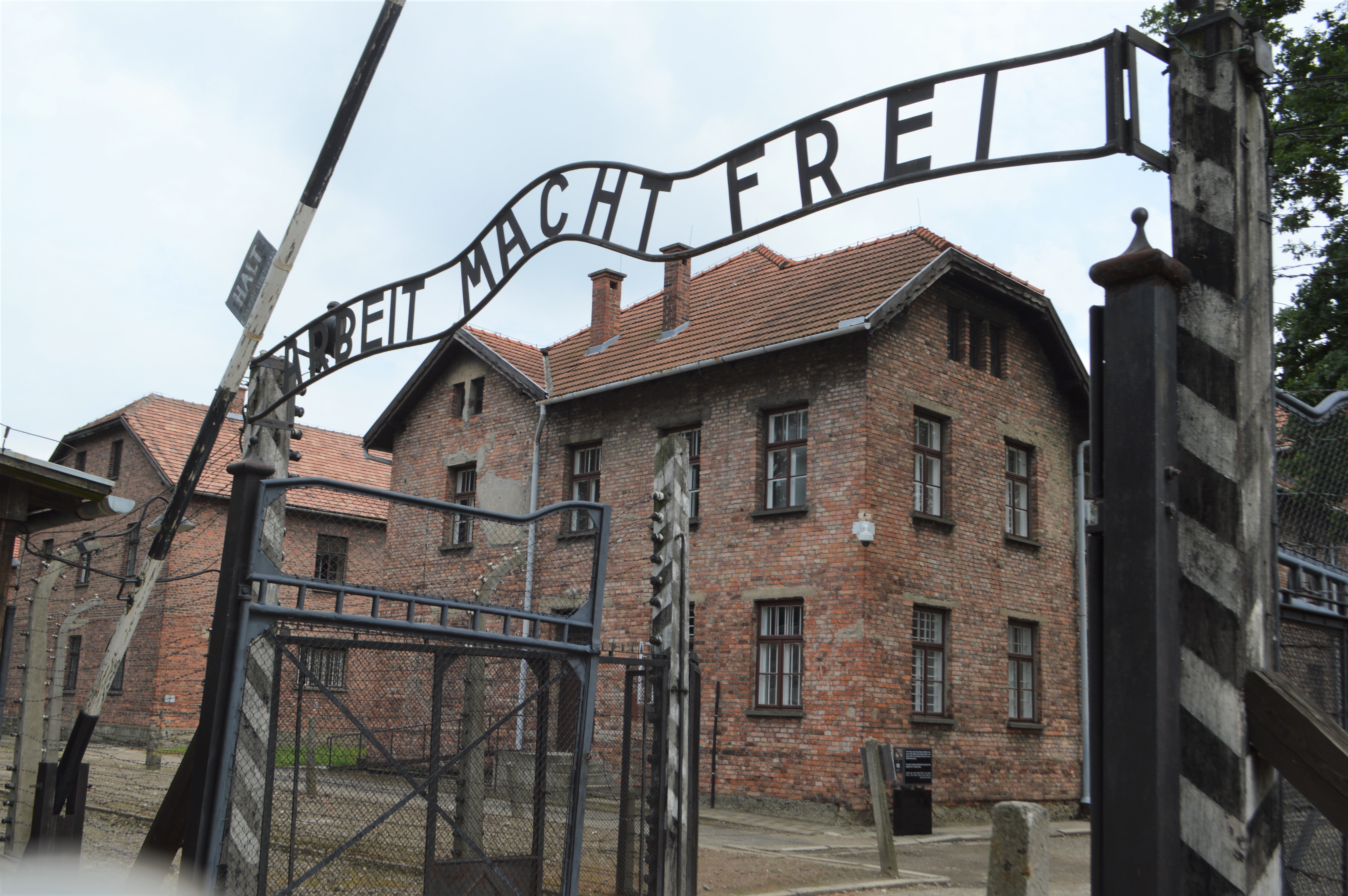
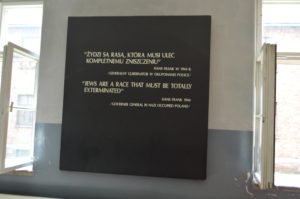
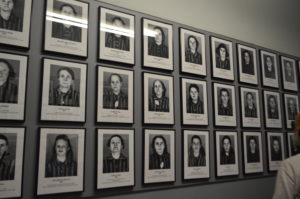
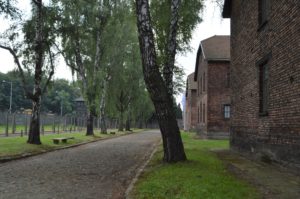


7 Comments
Comments are closed.